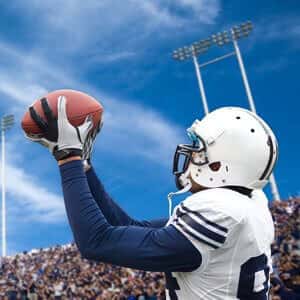
Everyone is focused on football because of the Superbowl. But there is growing concern that tackle football may affect the structure and function of adolescent brains and possibly result in brain damage.
Study Examines Brain Changes from Football:
A study published in JAMA Network Open tracked over 200 young football players and 70 young men who served as controls (JAMA Network Open, Feb.1, 2024). The average age was 16. The authors employed advanced neuroimaging techniques that revealed cortical thinning in the frontal and occipital regions in the football players but not in the controls.
Previous studies have shown that concussions sustained in football games can result in brain damage. These young players demonstrated diminished neural activity and neural signaling. This is of particular concern because the brain areas affected are important for mental health.
Earlier Research Linking Football Concussions and Brain Damage:
A team of investigators at Johns Hopkins put nine former NFL football players through a battery of high-tech tests, including PET scans and MRIs of the brain (Neurobiology of Disease, Feb. 2015). The men, between 57 and 74 years old, also completed tests of verbal learning and memory. Nine age-matched controls were put through the same tests.
The scientists were especially focused on a marker called translocator protein, a signal of brain damage. The overall findings indicate molecular and structural changes in the brains of the pro football players. These indicate lasting brain damage, possibly or probably as a consequence of hitting their heads so frequently.
When Do Changes Appear?
The researchers planned to look at the brains of active and retired players to see if the changes occur immediately. In a later study, they found indications of localized brain injury and repair, without changes in cognitive performance, among young NFL football players (JAMA Neurology, Jan. 1, 2017). More recently, they found higher levels of neuroimmune activation in the brains of former football players compared to athletes in non-collision sports (JAMA Network Open, Oct. 2, 2023). If scientists understand the consequences of concussion better, they might advocate for changes in the way contact sports are played.
Citations
- Zuidema TR et al, "Cerebral cortical surface structure and neural activation pattern among adolescent football players." JAMA Network Open, Feb.1, 2024. DOI: 10.1001/jamanetworkopen.2023.54235
- Coughlin JM et al, "Neuroinflammation and brain atrophy in former NFL players: An in vivo multimodal imaging pilot study." Neurobiology of Disease, Feb. 2015. DOI: 10.1016/j.nbd.2014.10.019
- Coughlin JM et al, "Imaging of glial cell activation and white matter integrity in brains of active and recently retired National Football League players." JAMA Neurology, Jan. 1, 2017. DOI: 10.1001/jamaneurol.2016.3764
- Rubin LH et al, "Imaging brain injury in former National Football League players." JAMA Network Open, Oct. 2, 2023. DOI: 10.1001/jamanetworkopen.2023.40580

